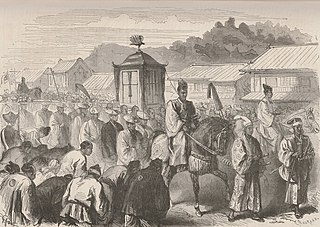Isolationism is a category of foreign policies institutionalized by leaders who assert that their nations' best interests are best served by keeping the affairs of other countries at a distance. One possible motivation for limiting international involvement is to avoid being drawn into dangerous and otherwise undesirable conflicts. There may also be a perceived benefit from avoiding international trade agreements or other mutual assistance pacts.

Leland Stanford Junior University is an American private research university in Stanford, California. Stanford is known for its academic strength, wealth, proximity to Silicon Valley, and ranking as one of the world's top universities.

The Shōgun was the military dictator of Japan during the period from 1185 to 1868. The shogunate was their administration or government. In most of this period, the shōguns were the de facto rulers of the country, although nominally they were appointed by the Emperor as a ceremonial formality. The shōguns held almost absolute power over territories through military means. Nevertheless, an unusual situation occurred in the Kamakura period (1199–1333) upon the death of the first shōgun, whereby the Hōjō clan's hereditary titles of shikken (1199–1256) and tokusō (1256–1333) dominated the shogunate as dictatorial positions, collectively known as the Regent Rule (執権政治). The shōguns during this 134-year period met the same fate as the Emperor and were reduced to figurehead status until a coup d'état in 1333, when the shōgun was restored to power in the name of the Emperor.

The Imperial Court in Kyoto was the nominal ruling government of Japan from 794 AD until the Meiji period (1868–1912), after which the court was moved from Kyoto to Tokyo and integrated into the Meiji government. The shogunate system came after the Imperial Court, with Minamoto no Yoritomo being the first to establish the post of the shōgun as hereditary, in 1192.
Tairō was a high-ranking official position in the Tokugawa shogunate government of Japan, roughly comparable to the office of prime minister. The tairō presided over the governing rōjū council in the event of an emergency. A tairō was nominated from among the fudai daimyōs, who worked closely with the Tokugawa traditionally. Generally, the office holder was the shogunate's chief policy maker, and provided Japan with a capable temporary leader in the absence of a shōgun, or in the event that the shōgun was incapacitated.

Iwashimizu Hachimangū (石清水八幡宮) is a Shinto shrine in the city of Yawata in Kyoto Prefecture, Japan.

Citizen Watch Co.,Ltd. is an electronics company primarily known for its watches, and is the core company of a Japanese global corporate group based in Tokyo. In addition to Citizen brand watches, it is the parent of American watch company Bulova, and is also known for manufacturing small electronics such as calculators.

The Neighborhood Association was the smallest unit of the national mobilization program established by the Japanese government in World War II. It consisted of units consisting of 10-15 households organized for fire fighting, civil defense and internal security.

Hotsumi Ozaki was an Imperial Japanese journalist working for the Asahi Shimbun newspaper, communist, Soviet Union intelligence agent, and an advisor to Prime Minister Fumimaro Konoe. The only Japanese person to be hanged for treason by the Japanese government during World War II, Ozaki is well known as an informant of the Soviet agent Richard Sorge.

Tyler Kingsley MacNiven is an American filmmaker and reality television contestant.

Minister of the Right was a government position in Japan in the late Nara and Heian periods. The position was consolidated in the Taihō Code of 702. The Asuka Kiyomihara Code of 689 marks the initial appearance of the udaijin in the context of a central administrative body called the Daijō-kan. This early Daijō-kan was composed of the three ministers—the daijō-daijin (Chancellor), the sadaijin and the udaijin.

Doi Toshikatsu was a top-ranking official in Japan's Tokugawa shogunate during its early decades, and one of the chief advisors to the second Tokugawa shōgun, Hidetada.
Sir George Bailey Sansom was a British diplomat and historian of pre-modern Japan, particularly noted for his historical surveys and his attention to Japanese society and culture.
Herbert Paul Varley was an American academic, historian, author, and Japanologist. He was an emeritus professor at Columbia University and Sen Sōshitsu XV Professor of Japanese Cultural History at the University of Hawaii.
Mark R. Peattie was an American academic and Japanologist. Peattie was a specialist in modern Japanese military, naval, and imperial history.

The Meiji Restoration, also known as the Meiji Renovation, Revolution, Reform, or Renewal, was an event that restored practical imperial rule to the Empire of Japan in 1868 under Emperor Meiji. Although there were ruling Emperors before the Meiji Restoration, the events restored practical abilities and consolidated the political system under the Emperor of Japan.
The Proletarian Masses Party was a short-lived political party in Japan. It was founded on July 22, 1928 by the Rōnō faction. Suzuki Mosaburō became the general secretary of the party. Yamakawa and Sakai Toshihiko functioned as 'elder' advisors in the party. Other prominent founders of the party were Kuroda, Inamura Junzo and Okada.
The Social Democratic Party was a political party in Japan between 1926 and 1932. Amongst the three main proletarian parties in Japan at the time, the Social Democratic Party occupied a rightist position.
Jeffrey Paul Mass was an American academic, historian, author and Japanologist. He was Yamato Ichihashi Professor of Japanese History at Stanford University.
The 2018 Stanford Cardinal football team represented Stanford University in the 2018 NCAA Division I FBS football season. The Cardinal were led by eighth-year head coach David Shaw. They played their home games at Stanford Stadium and were members of the North Division of the Pac-12 Conference.











